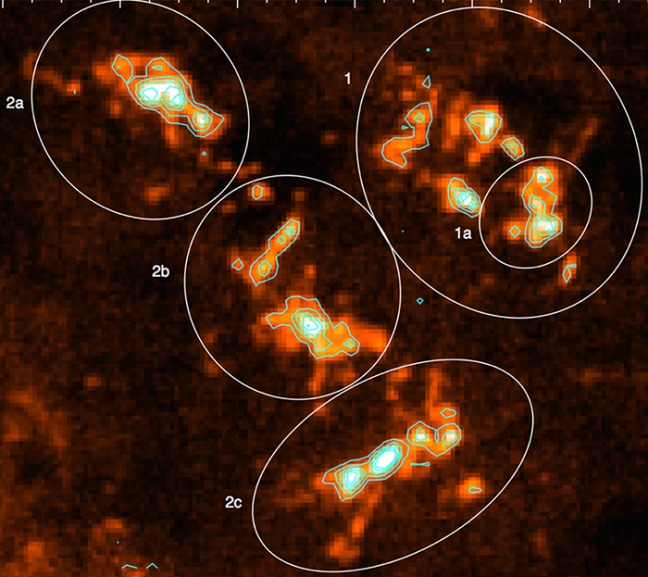Apr 16 2019
The first-ever high-resolution, radio telescope observations of the molecular clouds inside a massive star-forming region of the outer Milky Way have been made by astronomers from the United States and South Korea.
 This image from a radio telescope shows a huge star-forming region of the outer Milky Way galaxy. The ovals identify the main subdivisions of the region’s molecular cloud, including the smaller 1a, which is very efficient at producing stars. (Image credit: Charles Kerton).
This image from a radio telescope shows a huge star-forming region of the outer Milky Way galaxy. The ovals identify the main subdivisions of the region’s molecular cloud, including the smaller 1a, which is very efficient at producing stars. (Image credit: Charles Kerton).
This region is behind a nearby cloud of dust and gas. The cloud blocks the light and so we have to use infrared or radio observations to study it.
Charles Kerton, Associate Professor of Physics and Astronomy, Iowa State University
Kerton is also a member of the research team
Located nearly 14,000 light-years from Earth, the Milky Way region is known as CTB 102. It is classified as an HII region, suggesting that it includes clouds of ionized, or charged, hydrogen atoms. Moreover, due to its distance from Earth and the gas and dust in between, it has been challenging to study.
Therefore, “this region has been very poorly mapped out,” added Kerton.
The astronomers report their first outline of a new, higher-resolution map for the region in a paper that was accepted for publication recently in the Astrophysical Journal. Lead authors of the study are Sung-ju Kang, a staff scientist at the Korea Astronomy and Space Science Institute and a former graduate student at Iowa State University; and Brandon Marshall, a former Iowa State graduate student who has accepted a faculty position at the University of Nebraska at Kearney. Other co-authors are Kerton and Youngsik Kim, Minho Choi and Miju Kang, all of the Korea Astronomy and Space Science Institute. Kim is also associated with the Daejeon Observatory in South Korea.
According to Kerton, a newly commissioned radio telescope at the Taeduk Radio Astronomy Observatory in South Korea was used by the astronomers to capture high-resolution, carbon monoxide observations of the molecular clouds of the galactic region.
“That tells us the mass and structure of the material in the interstellar medium there,” stated Kerton.
In addition, the astronomers made a comparison of their radio observations with prevalent infrared data from the Wide-field Infrared Survey Explorer and the Two Micron All Sky Survey. Using the infrared data, they were able to classify young stars that formed within the molecular clouds of the region.
In their paper, the astronomers have reported that the data lead to three main observations.
Firstly, radio data were used by the astronomers to characterize the physical structure and properties of the newly mapped molecular clouds of the region—they are quite large, nearly 180 light-years wide with a mass of approximately 100,000 times that of the sun. Next, infrared data were used by them to determine the young stellar content within the clouds. Lastly, they studied the efficiency of star formation inside the galactic region by combining the two data streams.
According to the researchers, the star formation efficiency of the entire CTB 102 region is nearly 5%–10%, analogous to other giant molecular clouds inside the galaxy. However, one subregion of the clouds was found to have a star formation efficiency of 17%–37% (based on how the mass of the subregion is calculated). That is considerably higher compared to what would be expected for a subregion of its size. They propose that the subregion is the location of a massive cluster of young, emerging stars embedded in the molecular cloud.
Answering the question “Why all the star formation in one single subregion?” Kerton stated that this question makes for further research. He stated that there is perhaps something unique about the interstellar material in that subregion, which is close to the massive HII region.
This is our first look at all of this. The older data were just a few dots, a few pixels. We couldn’t isolate this relatively small region of the galaxy.
Charles Kerton, Associate Professor of Physics and Astronomy, Iowa State University
However, at present, they were able to achieve this by making use of the new South Korean radio observatory.
According to Kerton, the high-resolution observations of the study “are also a demonstration that the telescope is ideal for studying similar regions in our galaxy—there are many other potential targets.”